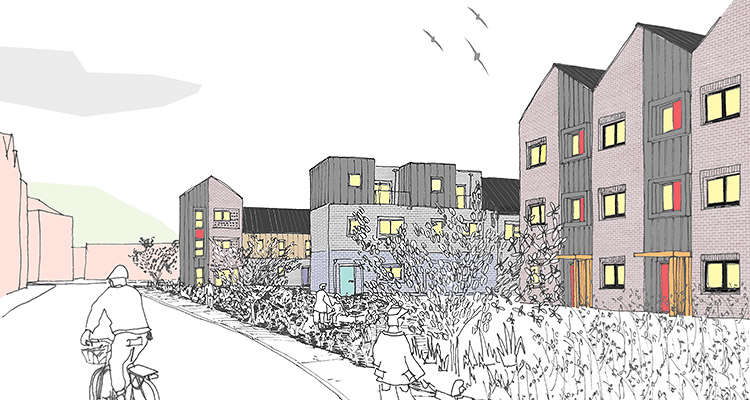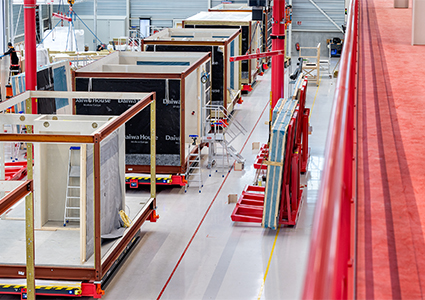
Daiwa House Modular Europe is leading a new era for UK housing with scalable and sustainable solutions
As a leading provider of modular construction solutions, Daiwa House Modular Europe (DHME) leverages its global expertise to create comfortable, and sustainable living solutions. With housing demand growing significantly across the UK and Europe, modular construction can help governments and local authorities achieve housing targets, and DHME can work collaboratively with partners to create future-proof solutions.
Since we last spoke with DHME around two years ago, the company has doubled down on its commitment to providing modular housing solutions, particularly in the UK.

“We’re expanding throughout Europe and the UK, with a focus on providing modular housing for the residential sector,” confirms Craig Garbutt, Managing Director UK. “The housing shortage in the UK has surpassed a critical threshold, and the national press frequently highlights issues related to the housing shortage, the lack of skilled labour required for the construction of much-needed housing, and the substantial financial resources allocated to temporary accommodation for homeless people.
“The government must move beyond merely discussing Modern Methods of Construction (MMC) strategies to support traditional house building and commit to a structured procurement strategy for housing development that levels the field for MMC and traditional methods of construction. The current procurement system for housing has been in place for years and has proven ineffective, resulting in repeated failures to achieve national housing targets. Consequently, the financial burden of temporary housing continues to increase year-on-year.”
Commenting on why DHME is at a strategic advantage in the UK, Craig continues: “Our UK business is in a favorable position, benefitting from the experiences of our European partners who have developed and are already delivering effective and sustainable MMC housing solutions across Europe. The solution is already proven to be efficient and can be delivered promptly at scale via a partnering model. The business strategy is to get our offering into the UK market via a similar partnering strategy with local authorities and housing associations, their preferred delivery partner, and DHME UK. The UK business can simply follow our European partners’ well-established and proven roadmap aimed at achieving the number of homes that can be built at scale from a cutting-edge factory delivering quality homes quickly and efficiently.
“When we have developed more strategic partnerships with a strong order pipeline, we will replicate our European factories in the UK. We are looking into developing a facility that can deliver both CAT 1 volumetric and CAT 2 panelised MMC solutions.
“As a business, we are acutely aware of the necessity for ‘meanwhile use’ temporary accommodation for homeless people throughout the UK,” Craig states. “Government figures indicate an alarming and ever-increasing spend on temporary accommodation for homeless people, with England’s local authorities currently spending a record £2.29 billion annually on temporary emergency accommodation, representing a 29 percent increase from the previous year’s expenditure of £1.77 billion. Of this expenditure, a significant £1.34 billion is allocated to nightly paid accommodations, which is a 55 percent increase compared to the previous year.

“These numbers are simply not sustainable! The escalating financial commitment highlights the chronic shortage of affordable and social housing, which leads to an increased reliance and dependency on temporary solutions. Whilst the latest commitment of £39 billion from the UK Government is welcomed, the allocation of funding requires further understanding. Realistically, planning reforms will take years to develop and adopt, followed by the construction period for new housing. This scenario highlights the difficulty in achieving the government’s target figures for new housing.”
With these increased pressures, the UK’s residential sector is increasingly searching for effective solutions, and DHME has an innovative option, having launched NARA (National Affordable Rapid Accommodation) to provide ‘emergency meanwhile use’ solutions. “We’ve used our decades of experience and expertise in modular solutions to create newly designed NARA units, which are available in one, two, or three-bedroom options and enable local authorities to procure units much faster than traditional construction,” Craig explains. “Once procured, due to the designed mobility, the units can be deployed to any site within weeks under an ‘emergency meanwhile use’ section of planning, allowing for quick placement and early occupation by tenants transitioning from hotel rooms.
“The NARA units are hot-rolled steel-framed, designed to be fully transferable and can be moved between sites as needed. They are predominantly built from non-combustible materials, presenting a reduced fire risk. The steel framed construction with optional concrete floor guarantees a strong and robust structure that can be deployed and further re-deployed indefinitely. The energy efficient units can also achieve an EPC A rating.
“NARA not only offers a safe and modern home where tenants can care for themselves and their families while waiting for a more permanent housing solution, but it presents further opportunities for local authorities. The units can be fully reused and converted into permanent housing with some adaptions when they reach their ‘end of use’ as a temporary home, making the business case and capital expenditure infinitely more economical.”
Commenting on some wider issues, Craig shares his thoughts on the UK construction sector’s approach to modular solutions. “I recently participated in the Built Environment Committee’s inquiry into MMC and what’s gone wrong,” he reflects. “Led by Lord Moylan, the committee’s findings made for uncomfortable reading for the UK Government, and while the inquiry was meticulous and revealing, a significant point made during questioning requires more attention. MMC volumetric solutions often appear more expensive on a project’s cost plan in comparison to a traditionally built scheme. However, this ‘race to the bottom’ procurement strategy is critically flawed because it overlooks the reduced time on site gained by using a volumetric solution.
“Using a traditionally built housing scheme of 30 homes as an example, a volumetric alternative could easily be delivered in half the time if the project is set up and procured correctly from the outset. Halving the site management costs and site duration makes a substantial impact to any cost plan. When you take that further with the reduced test, commission, and handover phases, and incorporate an enhanced quality assurance standard of housing, the project’s cost plans from traditional to volumetric are generally on par with each other.
“When all elements of the project cost plan, including early rental income and reduced spend on temporary accommodation, are correctly evaluated, a 3D volumetric modular system often turns out cheaper than a traditional scheme,” Craig states. “Government and local authorities must actively engage in the procurement of housing and correctly assess and incorporate all the elements of business case for a housing development, rather than simply relying on old procurement systems that have continually failed to deliver much needed housing.”
It’s no secret that the UK is facing unprecedented demand for housing, and our conversation with Craig clearly highlights DHME’s commitment to helping ease the UK’s housing crisis. Building on its extensive knowledge of modular construction, the company’s NARA units embrace the power of MMC and offer a scalable, efficient, and sustainable model to help solve the UK’s housing crisis.